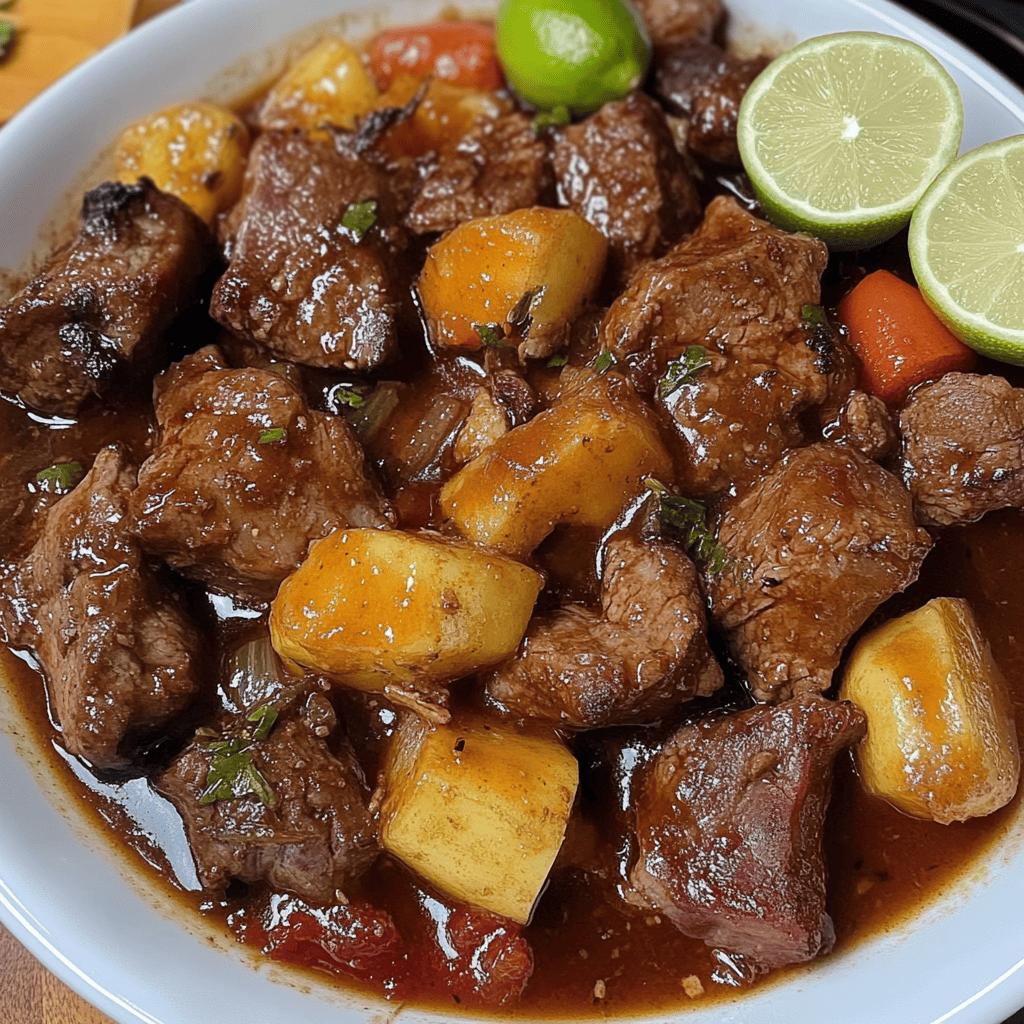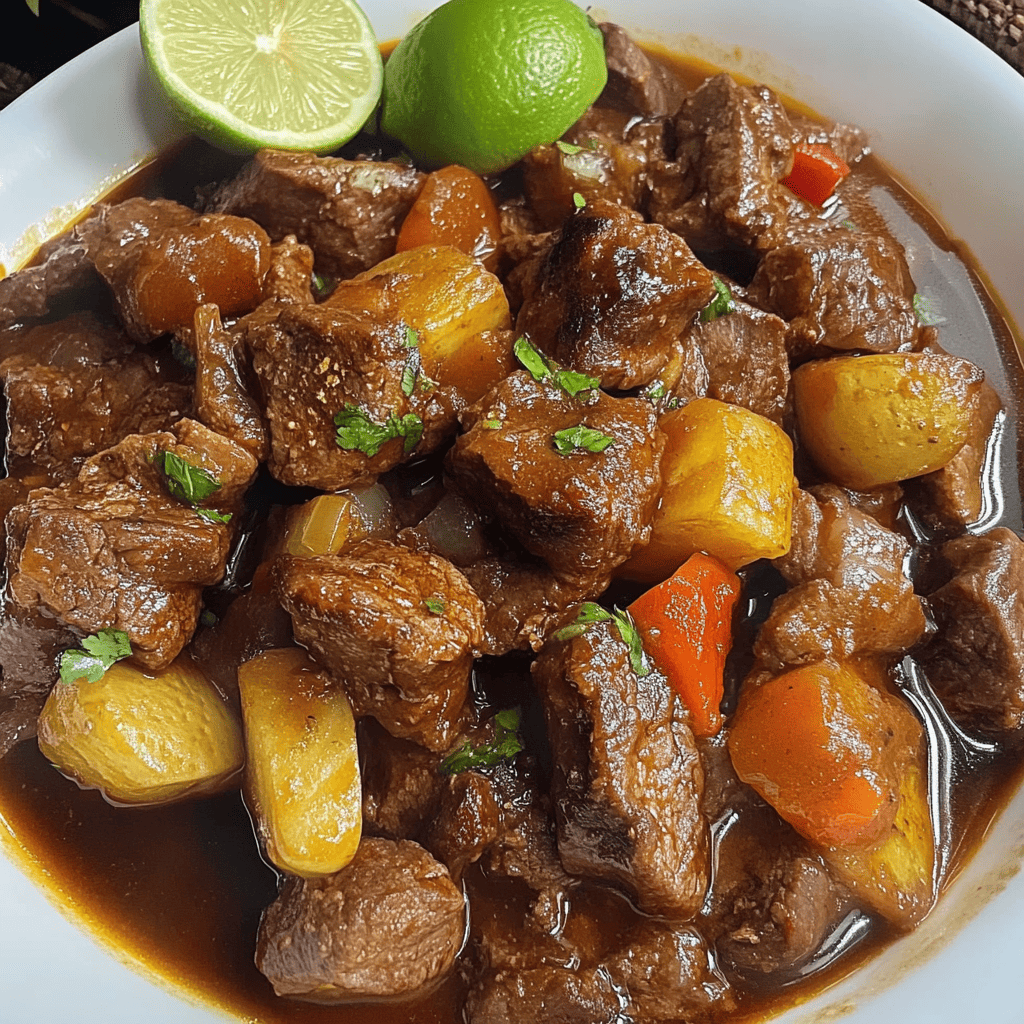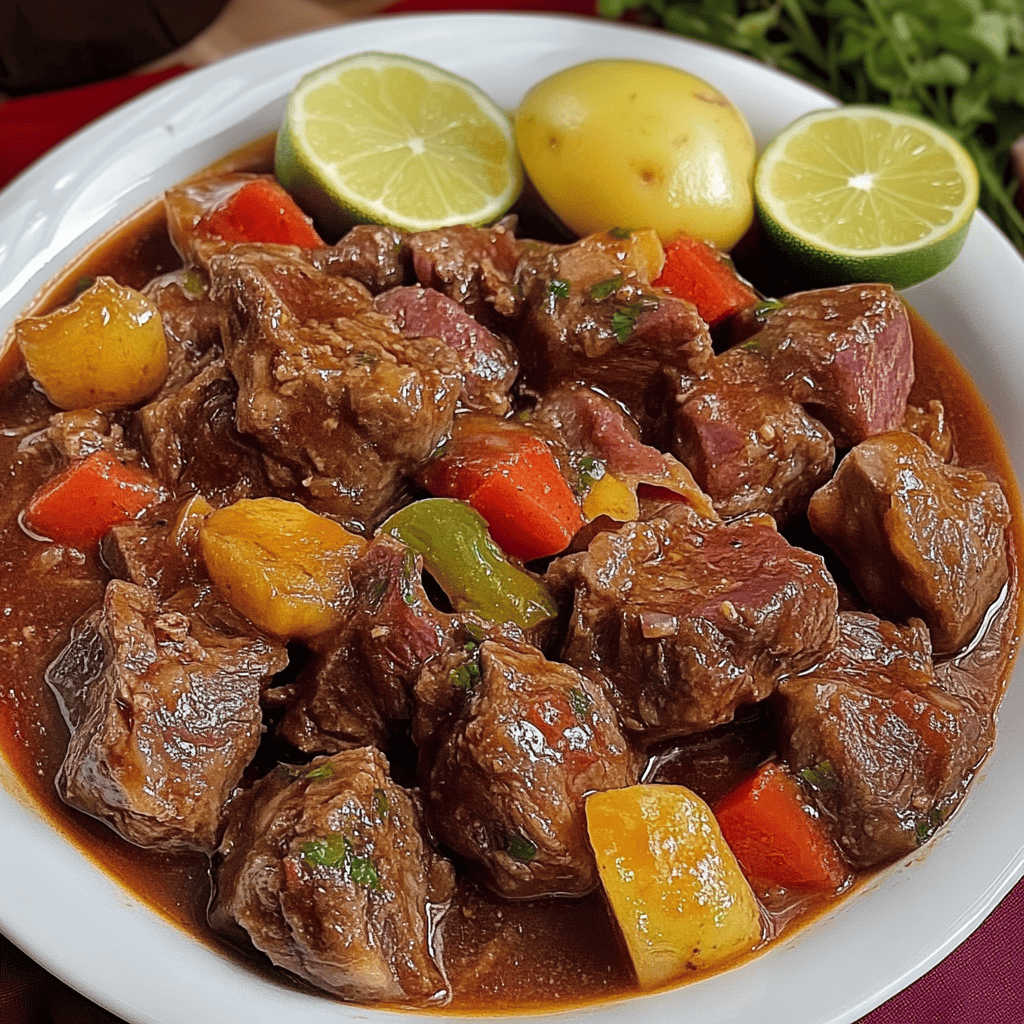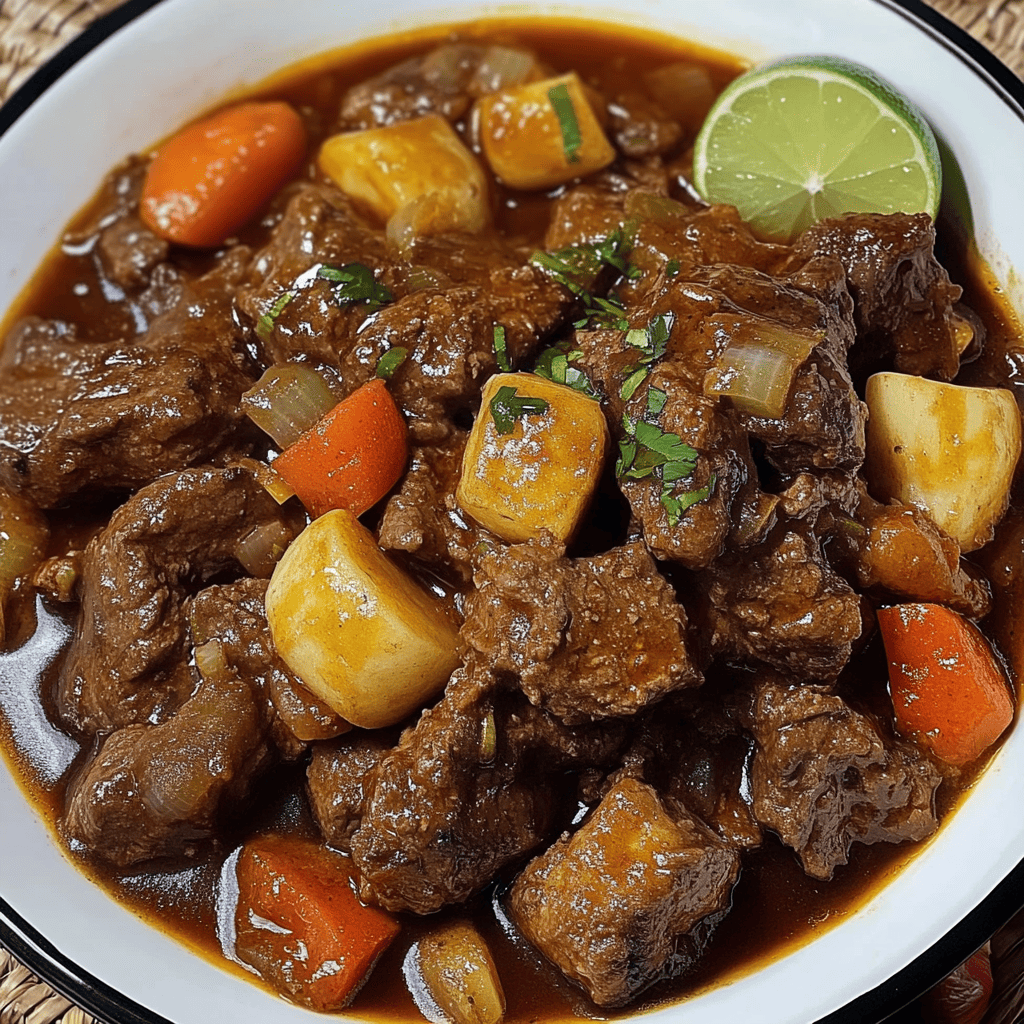Meatloaf: A Traditional and Delicious Stew
Introduction
Meatloaf is a traditional dish that stands out for its combination of intense flavors and its tender, juicy texture. This recipe is very popular in various Latin American countries and the Philippines, where it’s considered a homemade stew ideal for sharing with the family. Its preparation involves marinating the meat with spices and sauces and then simmering it with vegetables, creating a dish rich in flavor and with a thick, aromatic sauce.
This dish is versatile and can be served with white rice, bread, or even in tacos and sandwiches. Plus, its combination of ingredients like soy sauce, garlic, bay leaves, and peppers gives it a special touch that balances saltiness, acidity, and spiciness.
Mechado de carne is a traditional dish distinguished by its deep flavor and tender, juicy texture. It’s a stew made with meat marinated in spices and simmered with vegetables, allowing the flavors to blend perfectly. This recipe is extremely versatile and can be found in different versions throughout Latin America and the Philippines, adapting to the ingredients and preferences of each region.
The name “mechado” comes from the culinary technique of inserting strips of bacon or vegetables into the meat to make it juicier. However, in many modern preparations, instead of stuffing the meat, it’s cooked in a stew with a mixture of spices and sauces, achieving an equally delicious result.
This dish is ideal for special occasions, family gatherings, or simply enjoying a comforting meal at home. Its preparation requires patience, as slow cooking is key to achieving tender, melt-in-the-mouth meat. It can be served with rice, mashed potatoes, fried plantains, or bread, depending on each person’s preference.
Furthermore, mechado de carne is a recipe that allows for multiple variations. You can add red wine for a more intense flavor, or include ingredients like olives, capers, or potatoes for a more varied texture and flavor. Its versatility and richness of flavor have made it a highly appreciated dish in different cultures, making it a staple in homes.
In this recipe, we’ll explore step-by-step how to prepare homemade beef stew , full of flavor and with an unparalleled texture. Get ready to enjoy a delicious stew that will delight everyone at the table!
History of Meatloaf
Mechado de carne has its roots in Spanish and Filipino cuisine, where the technique of “mechar” (shredding) meat was used to add juiciness and flavor. Over time, this recipe has been adapted to various regions, incorporating local ingredients and variations in cooking methods.
In countries like Venezuela, “mechada” (shredded meat) is an iconic dish that forms part of the famous “pabellón criollo” (criollo pavilion). In the Philippines, “mechado” ( meat stew) is cooked with tomato sauce and potatoes and is a common dish at family gatherings and holidays. In other parts of Latin America, this stew has become a staple in homes, a symbol of comforting home cooking.
Meatloaf is a dish with deep roots in the traditional cuisine of several countries, especially in Latin America and the Philippines. Its origins date back to ancient food preservation techniques, where the “mechado” technique was used . This consisted of inserting strips of fat or vegetables into lean cuts of meat to enhance its flavor and keep it juicy during cooking. This practice was common in Spanish cuisine and was brought to the colonies during the era of conquest and colonization.
In Spanish cuisine , the term “mechar” referred to the practice of embedding strips of bacon into dried cuts of meat to add moisture and flavor. This technique was adapted to Latin America and the Philippines, where it was transformed into a richer stew using local ingredients like carrots, bell peppers, and tomato sauce.
In Venezuela , mechado de carne is part of the iconic “Carne Mechada,” an essential component of the popular national dish Pabellón Criollo , which combines shredded beef with rice, black beans, and fried plantains. In this country, the meat is slowly cooked with spices and vegetables until it becomes tender enough to shred, a characteristic that distinguishes it from other versions of mechado.
In the Philippines , “Mechado” is a stew with clear Spanish influences. It’s made with beef cooked in tomato sauce and enriched with ingredients like soy sauce, bay leaves, and chili peppers, giving it a unique flavor. Unlike the Venezuelan version, here the meat isn’t shredded, but cooked in large chunks until tender and juicy.
In other Latin American countries such as Mexico, Colombia, and Argentina, mechado de carne has variations in preparation, incorporating different types of meat, spices, and cooking methods. In some cases, it’s served with tortillas, accompanied with rice, or used as a filling for empanadas and arepas.
Over the years, this dish has evolved and adapted to the tastes of each region, while always retaining its essence: tender, juicy meat cooked in a delicious, flavorful sauce . Today, mechado de carne remains a popular dish in home cooking and a symbol of tradition in many cultures.

RECIPE AND INGREDIENTS
Ingredients:
• 1 kilogram of diced beef
• ⅓ cup of soy sauce
• ½ sliced lemon (juice)
• ground black pepper
• 5 garlic cloves
• 1 medium onion
• 2 carrots
• 2 medium potatoes
• 1 large green pepper
• cooking oil
• 180 g of tomato sauce
• 1 beef stock cube
• Thai chili
• 4 bay leaves
• water
Preparation:
In a bowl, combine the beef, soy sauce, lemon juice, and pepper. Mix well and let it marinate for 1 hour.
Add oil to a pan, sauté the garlic and onion until they give off a pleasant aroma. Add the marinated beef and sauté for 1 minute.
Add the bay leaves and marinade sauce, stir. Cover and cook for 20 minutes, stirring occasionally.
Add the tomato sauce, stir to combine. Add 2 cups of water, the diced beef, and chili, stir. Cover and cook for 40 minutes to 1 hour, or until tender (add water if necessary). Add the carrot and potato and cook until tender. Then add the bell peppers and cook for a few minutes, or until the sauce is softened.

Questions about Meatloaf
- Why is the dish called “mechado”?
- The term “mechado” comes from the technique of adding ingredients to meat to make it juicier, although in this version it refers more to slow cooking with sauce.
- What type of meat is best for this recipe?
- Cuts such as skirt steak, chuck, or stew meat are recommended, as they absorb flavors well and become tender when cooked slowly.
- Can I make this dish without spice?
- Yes, you can omit the Thai chili if you prefer a milder version.
- How long should I marinate meat for best flavor?
- Ideally, you should let it marinate for at least an hour, but if you let it sit overnight, it will absorb even more flavors.
- Can it be made in a pressure cooker or a slow cooker?
- Yes, in a pressure cooker, the cooking time is reduced to approximately 30 minutes, while in a slow cooker, it can be cooked on low heat for 6-8 hours to obtain a very tender texture.
- What side dishes go well with this dish?
- It can be served with white rice, mashed potatoes, fried plantains, or homemade bread.
Questions about Meatloaf
- What is the origin of meatloaf and in which countries is it most popular?
- What does “mechar” mean in cooking and how was it applied in traditional recipes?
- What is the difference between meatloaf in Venezuela and in the Philippines?
- What types of meat can be used to make a good meat stew?
- What are the essential ingredients that cannot be missing in this recipe?
- What side dishes or accompaniments are ideal to serve with this dish?
- How can you make the meatloaf juicier and more tender?
- Is it possible to prepare beef tenderloin in a slow cooker or pressure cooker?
- What variations of meat mechado exist in other Latin American countries?
- Can beef be substituted with another protein in this recipe?
Other Information about Meatloaf
- Marinating to enhance flavor : It is advisable to marinate the meat for several hours (or even overnight) so that it absorbs the flavors of the soy sauce, garlic, pepper, and other seasonings.
- Cooking Times : The key to achieving tender shredded beef is slow cooking. It can take between 1 and 2 hours depending on the type of meat and cooking method.
- Cooking Options : In addition to a conventional pot, the beef tenderstem can be prepared in a pressure cooker to reduce cooking time or in a slow cooker to achieve an even softer texture.
- Substitutions and variations : Some recipes include red wine for extra depth of flavor, while others add olives, capers, or a spicy kick with chili peppers.
- Use in other preparations : The meatloaf is so versatile that it can be used as a filling for empanadas, arepas, tacos or even as a side dish in a main dish with rice or mashed potatoes.
This dish, besides being delicious, is an excellent choice for family gatherings and holiday meals, as it can be prepared in large batches and keeps well in the refrigerator for several days. A traditional recipe that never goes out of style!
- Variations: Some versions add red wine or beef broth to give it more depth of flavor. Olives or capers can also be added for a Mediterranean touch.
- Storage: Can be refrigerated for up to 3 days or frozen for 1 month without losing its flavor.
- Recipe improvements: For a softer texture, the meat can be cooked in large chunks and then shredded before serving.
Estimated preparation time:
- Preliminary preparation: 15 minutes
- Cooking time: 1 hour and 15 minutes (approximately)
- Total: 1 hour and 30 minutes
Texture and flavor:
- Texture: The meat is tender and juicy, easily flaking. The vegetables are soft and well-integrated with the sauce.
- Flavor: Rich, deep, and slightly smoky with umami notes from the soy sauce, natural sweetness from the vegetables, and a touch of acidity from the lemon. Chili, if used, adds a subdued heat.
Consumption context:
- Ideal as a main dish for family lunches, comforting home-cooked meals, or even special occasions.
- It is commonly served with white rice, mashed potatoes or bread.
Visual appearance:
- A bright reddish-brown stew with generous chunks of meat and colorful vegetables. Bay leaves and sliced peppers add pleasing visual touches.
Curiosities:
- “Mechado” traditionally involves adding garlic or vegetables to the meat, but today it refers to slow cooking where the meat falls apart or “shreds” easily.
- It is very popular in Latin American countries, especially in Venezuela, where there is an emblematic version: “carne mechada.”
Estimated nutritional value (serving approx. 250 g):
- Calories: ~350–400 kcal
- Protein: ~30 g
- Fat: ~18 g
- Carbohydrates: ~20 g
- Fiber: ~3 g
- Sodium: High, due to soy sauce and bouillon cube (can be reduced by using low sodium options)
Additional benefits and interesting facts:
- High protein content, ideal for maintaining satiety.
- Vegetables provide fiber, vitamins and minerals.
- It can be easily adapted: change the type of meat, use seasonal vegetables, or cook it in a pressure cooker or slow cooker for more convenience.

Detailed Conclusion
Mechado de carne is a traditional dish that stands out for its combination of flavors, its tender texture, and its thick, aromatic sauce. Thanks to its pre-marinating and slow cooking, each bite is infused with spices and juices that make it irresistible.
It’s a versatile recipe that can be adapted to different tastes and needs, allowing for changes in ingredients or cooking methods depending on the availability of each kitchen. Its easy storage makes it an excellent option to prepare in advance and enjoy with different meals.
Without a doubt, mechado de carne (meat stew) is an example of the culinary richness of different cultures, remaining a comforting dish steeped in tradition. Whether served with rice, bread, or vegetables, this stew continues to win over palates and remain a favorite in many homes. Go ahead and prepare it and enjoy its unparalleled homemade flavor!
Mechado de carne is a dish that has transcended borders and generations, maintaining its essence as a comfort food, full of flavor and with great cultural value. Its history and evolution reflect the culinary richness of different countries, from its roots in Spanish cuisine to its variations in Latin America and the Philippines.
The key to its success lies in the slow-cooking technique , which allows the meat to absorb the flavors of the spices and sauces, achieving a juicy and tender texture. Ingredients such as soy sauce, tomato, bay leaves, and vegetables add depth to the dish, while its versatility allows for a variety of accompaniments and presentation options.
In Venezuela, mechado de carne is an essential part of the Pabellón Criollo (Criollo Pabellón) , representing the country’s culinary identity. In the Philippines, its version with Asian touches and soy sauce turns it into a special stew often served on festive occasions. In other regions, it’s enjoyed in tacos, empanadas, arepas, or simply accompanied by rice and salads.
Beyond its preparation, this dish holds special significance in home cooking, as it’s a recipe that unites families around the table and is passed down from generation to generation. Furthermore, its ability to adapt to different tastes and cooking styles makes it a must-have in any recipe book.
Ultimately, mechado de carne is a perfect example of how tradition and innovation can coexist in gastronomy , maintaining its essence yet evolving over time. Its unparalleled flavor and versatility make it a must-try for those looking to enjoy a home-cooked meal steeped in history and tradition. A delight for the palate that never goes out of style!

